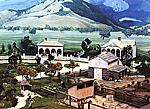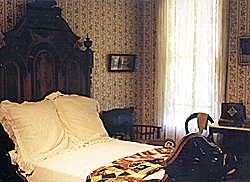 You'll find the Sharpsteen Museum and Brannan Cottage on Washington Street next to the Police/Fire Department. Hours are 10am to 4pm in summer and noon to 4 pm in winter, daily. Volunteers staff the museum and admission is free. Four times a year, special exhibits are produced highlighting pioneer life. The museum and cottage are connected.
You'll find the Sharpsteen Museum and Brannan Cottage on Washington Street next to the Police/Fire Department. Hours are 10am to 4pm in summer and noon to 4 pm in winter, daily. Volunteers staff the museum and admission is free. Four times a year, special exhibits are produced highlighting pioneer life. The museum and cottage are connected.
At right, diorama of Sam Brannan's "Hot Springs of the West" resort. Left middle shows the Brannan cottage with four archways. Large Diorama photo (slow: 179K)
The Sharpsteen Museum transports you back to 1860s Calistoga, with a diorama of Sam Brannan's "Hot Springs of the West" resort, a restored stagecoach placed against a mural to make it look like you're pulling into town, Molly Patton's Toll House, a tribute to Robert Louis Stevenson (who visited and wrote The Silverado Squatters about the nearby silver mine), a piece on "Black Bart," and other local exhibits.
Ben Sharpsteen is an Oscar-winning Disney animator who joined the Disney company in 1929 and helped make and direct Snow White, Fantasia, Dumbo, and other films, as well as a wide variety of short films starring Mickey Mouse, Donald Duck, and other Disney cartoon characters. He accepted the Oscar for Seal Island, a documentary about seals in Alaska, and went on to direct 12 more of these True Life Adventures--eight of which won Oscars.
Also in the 1950s, he produced 15 of 17 films in a series called People and Places. Three of his 15 won Oscars, including The Ama Girls. The Oscar for The Ama Girls sits in the museum, a gift from Walt. Sharpsteen retired in 1959 to a ranch in Calistoga bought by his grandmother back in the 1800s.
Born on Nov. 4 1895 in Tacoma, Washington, Sharpsteen moved to Alameda, Calif. as a child and eventually graduated from Univerity of California, Davis, in 1916 with a degree in Farming. He served in the Marine Corps during WWI on Guam, and after the war, went to NY to try his hand at cartooning, moving to San Francisco and then back to New York working for a number of companies before joining Disney in 1929.
He started the museum to showcase the local history, although initially, his ideas fell on deaf ears and tight pursestrings. With the last remaining cottage from San Brannan's once popular resort left, Sharpsteen's perserverance paid off as the city and volunteers finally came together, and much work later, preserved the cottage, built a diorama, and got the museum up and running.
Black Bart
The "Gentleman Bandit," a.k.a. "Black Bart," specialized in stagecoach holdups around the Calistoga area. Dressed in black, he was polite when he held up the stages, preferring the money boxes to personal effects. After each hold up, he would leave bits of verse behind, until one day, ambushed by a curious farmer as he was holding up another stagecoach, he fled, dropping a hankerchief behind.
For eight years he had terrorized the stage lines. A bit of detective work traced the hankerchief back to a Charles E. Boles--a wealthy socialite in San Francisco who supported his lavish lifestyle by robbery. He was sentenced to prison, released with time off for good behaviour, and then disappeared.
Brannan Cottage
Sam Brannan, born in 1819 in Maine and a printer by trade, published a Mormon newspaper in New York before talking his way into leading Mormons from New York to California via Cape Horn. In a land scheme that boggled the imagination, he gained funds to outfit a ship called the Brooklyn, and essentially doublecrossed the "limited partnership" that put up the funds.
The Brooklyn docked in Yerba Buena (now called San Francisco) in 1846, and he established himself as a publisher again. The California Star was the first newspaper to proclaim the discovery of gold.
As gold fever spread, he demanded that every Mormon give the church a tithe--he, of course, collecting it. When Brigham Young heard about the scheme, he sent a pair of emissaries to collect the money. Although Brannan allowed that the money belonged to the Lord, he told the emissaries that he'd give up the Lord's share when Young sends him a receipt signed by the Lord!
With these funds in hand, he invested in real estate, the railroad, telegraph, express companies, and banks. He was the first millionaire in California, owned almost a fifth of San Francisco and a quarter of Sacramento, and helped found Yuba City and Calistoga. Active in society, when gangs began terrorizing San Francisco, he created and led a volunteer police force that quickly cleaned up the town and deported the lawless. Later, when a group called the Ducks tried to take over the city, Brannan organized the Committee of Vigilance and suppressed the Ducks.
In 1859, he started a dream project to create a spa and resort, which he called Calistoga, to take advantage of the hot springs and mineral waters of the area. Multiple explanations abound on how he named the town. One is that he took the "Cali" from California, added an "s" for euphony, and combined it with "toga" from Saratoga--the spa town in New York state. Another version has "Cali" meaning hot paired with "toga" as it Roman robes because the baths were like a warm robe and good for your health. A more popular version is that Brannan, who was very fond of alcohol, was drunk when he vowed to "build the Calistoga of Sarafornia."
At right, inside the living room of Sam Brannan's cottage.
Large interior photo (slow: 139K)
Worse, his wife discovered his affair with a European dancer and divorced him, taking half of his assets--$500,000 of his money--and leaving him with mortgaged holdings. The next decade was a nightmare of liquidation as he failed to pay his bills--and another nightmare of liquification as he slowly drank himself into oblivion.
One last fling with investments concerned a grant of property in Northern Mexico, with the proviso that he settle on it--something the local Indians objected to. Brannan never attracted support and settled in the San Diego area, where he died in poverty on May 14, 1889, aged 70 years.
Museum Shop
A pair of 28-page booklets, both reprints of various articles, served as sources for the historical aspects of Calistoga, the Sharpsteen Museum, and Brannan Cottage. About Ben Sharpsteen and About Sam Brannan contain much more than my summary, and at $4.75 each, are quite the bargain and quite the read.
Sharpsteen Museum
More Napa Valley
This article appears in MagWeb (Magazine Web) on the Internet World Wide Web. The Sam Brannan cottage, accessible through the museum, offers a wide array of Americana as it would have appeared in the late 1800s. It is the last cottage of a failed resort begun by this combination scoundrel and visionary who is also the founder of Calistoga. The cottage contains a bedroom, parlour, and dining room complete with period furnishings. A display of toys is just outside the entrance.
The Sam Brannan cottage, accessible through the museum, offers a wide array of Americana as it would have appeared in the late 1800s. It is the last cottage of a failed resort begun by this combination scoundrel and visionary who is also the founder of Calistoga. The cottage contains a bedroom, parlour, and dining room complete with period furnishings. A display of toys is just outside the entrance.
 The land was leveled and landscaped, and Brannan proceeded to build hotel, the cottages, express office, store, bath house, railroad, and other buildings. He poured most of his fortune into the place, but it was not a success.
The land was leveled and landscaped, and Brannan proceeded to build hotel, the cottages, express office, store, bath house, railroad, and other buildings. He poured most of his fortune into the place, but it was not a success.
1311 Washington St.
PO Box 573
Calistoga, CA 94515
707-942-5911
Napa Valley (Calistoga, CA, USA)
Sharpsteen Museum and Brannan Cottage (Calistoga, CA, USA)
Napa Valley Museum (Napa Valley, CA, USA)
Stonegate, Sterling, and Beringer Wineries (Napa Valley, CA, USA)
Back to List of Historical Sites
Back to Travel Master List
Back to MagWeb Master List of Magazines
© Copyright 1999 by Coalition Web, Inc.
Other military history articles and gaming articles are available at http://www.magweb.com